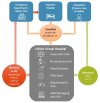COVID-19 Proactive Disease Management Using COVID Virtual Hospital in a Rural Community
- PMID: 37483559
- PMCID: PMC10358976
- DOI: 10.17294/2330-0698.1998
COVID-19 Proactive Disease Management Using COVID Virtual Hospital in a Rural Community
Abstract
Purpose: A community teaching hospital serving a rural population established an intensive "hospital at home" program for patients with COVID-19 utilizing disease risk stratification and pulse oximeter readings to dictate nurse and clinician contact. Herein, we report patient outcomes and provider experiences resulting from this "virtual" approach to triaging pandemic care.
Methods: COVID-19-positive patients appropriate for outpatient management were enrolled in our COVID Virtual Hospital (CVH). Patients received pulse oximeters and instructions for home monitoring of vital signs. CVH nurses contacted the patient within 12-48 hours. The primary care provider was alerted of the patient's diagnosis and held a virtual visit with patient within 2-3 days. Nurses completed a triage form during each patient call; the resulting risk score determined timing of subsequent calls. CVH-relevant patient outcomes included emergency department (ED) visits, mortality, and disease-related hospitalization. Additionally, a survey of providers was conducted to assess CVH experience.
Results: From April 22, 2020, to December 21, 2020, 1916 patients were enrolled in the CVH, of which 195 (10.2%) had subsequent visits to the ED. Among those 195 ED visits, 102 (52.3%) were nurse-directed while 93 (47.7%) were patient self-directed; 88 (86.3%) nurse-directed ED visits were subsequently admitted to inpatient care and 14 were discharged home. Of the 93 self-directed ED visits, 3 (3.2%) were admitted. A total of 91 CVH patients (4.7%) were ultimately admitted to inpatient care. Seven deaths occurred among CVH patients, 5 of whom had been admitted for inpatient care. Among 71 providers (23%) who responded to the survey, 94% and 93% agreed that the CVH was beneficial to providers and patients, respectively.
Conclusions: Proactive in-home triage of patients with COVID-19 utilizing a virtual hospital model minimized unnecessary presentations to ED and likely prevented our rural hospital from becoming overwhelmed during year one of the pandemic.
Keywords: COVID Nursing Questionnaire; COVID-19; primary care; pulse oximeter; virtual hospital; virtual visits.
© 2023 Advocate Aurora Health, Inc.
Conflict of interest statement
Conflicts of Interest None.
Figures


References
-
- Totten AM, McDonagh MS, Wagner JH. AHRQ Methods for Effective Health Care Report No. 20. EHC015 Agency for Healthcare Research and Quality; May, 2020. The evidence base for telehealth: reassurance in the face of rapid expansion during the COVID-19 pandemic [internet] https://effectivehealthcare.ahrq.gov/sites/default/files/pdf/telehealth-... . - PubMed
LinkOut - more resources
Full Text Sources
Miscellaneous
